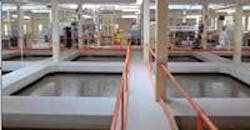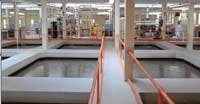Planning Key to Successful Large-Scale Membrane Implementation
By Douglas R. Lubben and Paul J. Delphos
Advance planning, along with creating a solution tailored for the specific needs of the community, means the difference between success and failure of large-scale membrane treatment system deployments. This article is intended to serve as a guide for anyone considering a membrane treatment system.
Increasingly, owners of the larger systems are turning to membrane technology to treat their communities' water. The cumulative number of low-pressure membrane installations has grown exponentially in the U.S. over the past 10 years. For example, 28 membrane facilities were installed between 1990 and 1995. Between 1996 and 2000, the number of installations jumped to 82.
There are more than 54,000 potable water systems in the U.S., and these systems account for approximately 38,000 mgd of treated water capacity on a calculated average basis, according to USEPA. While only around one percent of these systems are more than 15 mgd, larger systems account for approximately 44 percent of the treated water capacity.
Create a Road Map
One of the key precursors to implementing a large-scale membrane treatment system is developing a memorandum of understanding (MOU) or similar document with the local regulatory agency for your state, since comfort levels with this emerging technology vary. The role of the MOU is to provide a framework for delivery of the membrane project.
For example, before it began its procurement process for two low-pressure membrane treatment facilities with a combined ultimate capacity of 160 mgd, Minneapolis Water Works (MWW) met with the Minnesota Department of Health to develop a MOU that included:
• An overview of MWW's commitment to continuous production of quality drinking water
• The role of membrane filtration in system improvements
Information on multiple barrier treatment and granting of microorganism log-removal credits for membrane filtration and existing membrane treatment processes
Goals of the Columbia Heights Membrane Procurement Project with respect to permeate quality, integrity testing, and process optimization
• Performance testing protocols and data collection requirements
The City of Lancaster, PA, created a similar document called the Membrane Piloting Program Overview and Guidelines. The document contained bidding protocols, anticipated water quality criteria and membrane vendor requirements. It also outlined the project duration and any anticipated regulatory requirements. City staff, regulatory agency staff and membrane vendors all received copies of the document.
Do Your Homework
Because the low-pressure membrane industry is in its infancy compared to the high-pressure membrane marketplace, the rate of product change is rapid and some suppliers may tend to promote their own products as the standard everyone should aspire to.
The industry also contains newer players who are eager to establish themselves and will offer more aggressive pricing to gain market share. The key here is the amount of redundancy in your water system. For example, since Lancaster has to rely on two plants to serve 250,000 residents, it mandated installation experience in the bidding process. For utilities that can purchase water from a backup source in case of system failure, the aggressive pricing offered by less-established players may be a viable option.
Comparing and contrasting the products, pricing and experience of different membrane manufacturers is critical. Manufacturers offering low-pressure membrane products in the U.S. include Zenon, US Filter, Pall, Aquasource/Ondeo, Ionics/Norit, Koch and Hydranautics/Leopold.
Game Plan
For owners of smaller systems, system selection poses far fewer challenges than for owners of large systems. Large-system owners need to have a documented game plan for system selection, to minimize the risks of challenges from suppliers who aren't selected for these large-dollar projects.
Minneapolis Water Works defused the potential for challenges by spelling out the criteria for selection up front, then opening the bidding process to all vendors. Potential bidders self-selected based on these criteria, and as a result only four suppliers bid on the project. And because each qualifying supplier was required to participate in a performance-testing program, MWW was assured of getting the best-performing membrane equipment at the best price.
Lancaster followed a similar pre-qualification process, specifying experience in both installation and operations. In this instance, vendors had to have an installation with a flux of 40 in operation for at least one year.
The evaluation process can also be narrowed by membrane type. The Minneapolis Water Works team tested only clarified-feed membranes because team members knew the utility would continue using its current coagulation, flocculation and sedimentation systems. The City of Lancaster wanted to balance the risks between its existing pre-treatment systems and the pre-treatment of membranes only (direct feed), so it is testing both, perhaps the first test of its type in the U.S.
Utilities building new facilities may want to examine both clarified-feed and direct membranes, as Lancaster is doing; communities whose water doesn't require pre-treatment can skip the clarification process.
Community Buy-In
For a membrane-system implementation to be successful, the process to gain community buy-in should begin as early as possible. MWW assembled community stakeholders to form a Citizen's Advisory Committee (CAC) a full two years before seeking the city's approval. The committee included representatives from the health department, a local university, a city engineer from one of the suburbs, the Minneapolis Health Board, the city finance department, and the Minnesota AIDS project. The committee also advised the Minneapolis Mayor and City Council on the implementation of MWW's Capital Improvement Program. Committee members were briefed on water quality standards, waterborne pathogens, infrastructure, and legal and financial issues by experts in each of these fields.
The City of Lancaster hosted a number of public workshops, where the public was provided the opportunity to ask questions of both city staff and HDR engineers. It also held tours during the piloting process. Additional information is being made available through water billing inserts and a project web site.
Pilot Testing
The goal of pilot testing, or performance testing, is to make sure a system works as intended, and is compatible with the unique qualities of the water it treats. Additionally, the term "pilot" indicates that the test unit is smaller scale than what might be considered for the full-scale installation. It is of considerable advantage to have the testing unit equipped with full-scale modules, as was the case at MWW. This aspect will help to address scaling issues encounter with smaller "pilot" units.
No two pilot studies are alike. MWW's pilot testing was tightly integrated into its unique procurement process and included three separate phases. Phase I was the commissioning or start-up phase, in which vendors hooked up the equipment to be tested and made sure it operated properly. During Phase II, the owner, in this instance HDR engineers acting on MWW's behalf, began operating the equipment under the vendors' direction. During this phase, vendors experimented with settings to find the most optimal ones. The selected parameters were "locked in" during Phase III, to represent sustained real-world operating conditions and to ensure a level playing field among the systems being tested.
As part of the Lancaster pilot study, HDR hosted a membrane piloting workshop for representatives of more than 30 public water systems and two state regulatory agencies, and the attendees were invited to tour the pilot units from each manufacturer.
Summary
Getting buy-in from community stakeholders, making sure that a wide variety of products are independently evaluated, developing a game plan for selection, and testing the systems under consideration — all of these steps are necessary for successful membrane implementation. While they require advance planning that can sometimes be measured in years, they're worth it in the end.
About the Authors: Doug Lubben is a project manager in HDR's Minneapolis office and has been working with MWW since 1997. The first 70 mgd phase is under design and expected to be operational by October 2004. Paul Delphos is a water section manager in HDR's Norfolk, VA, office and is working with the City of Lancaster. Both are members of HDR's membrane technology team.
